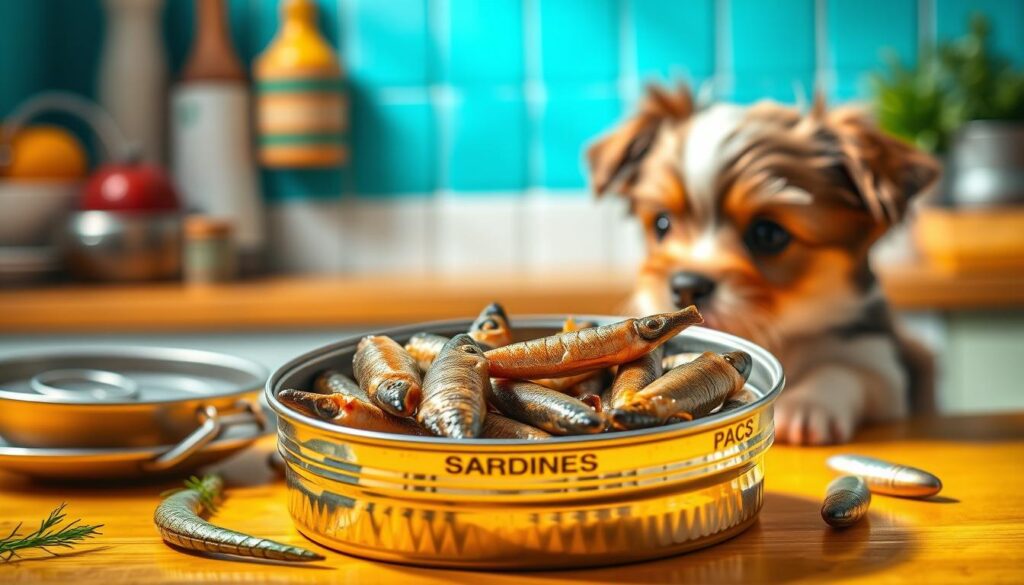As a devoted dog parent, you’re always looking for healthy treats for your furry friend. Canned sardines are popular for their health benefits. But are they safe for your dog? Let’s explore the world of sardines and how they fit into your dog’s diet.
Sardines are packed with nutrients that can benefit your dog’s health. They support heart health, brain function, and a shiny coat. But, it’s important to know how to safely introduce sardines to your dog. With the right approach, canned sardines can be a tasty and healthy part of your dog’s meals.
Table of Contents
Understanding Sardines as Dog Food
Sardines are a great choice for dog food. They are small, oily fish full of good stuff for your dog. They have lots of omega-3 fatty acids and protein, which are good for your dog’s health.
Types of Sardines Available
You can find sardines in fresh, frozen, and canned forms. Each type has its own benefits. Fresh and frozen sardines are the most nutritious. Canned sardines are easy to store and use.
Nutritional Profile of Sardines
Sardines are full of omega-3 fatty acids. These are good for your dog’s heart, joints, and brain. They also have high-quality protein and important vitamins and minerals like vitamin D, calcium, and phosphorus.
Why Consider Sardines for Dogs
Adding sardines to your dog’s diet can be very beneficial. They help keep your dog’s coat and skin healthy. They also support joint mobility and cognitive function. Plus, they have anti-inflammatory properties that can help with health issues.
Feeding sardines to your dog can be a smart choice. They can be a tasty and nutritious treat or a regular part of their meals.
Health Benefits of Sardines for Dogs
Sardines are a tasty treat for dogs and offer many health benefits. They are small, oily fish full of nutrients. These nutrients help with heart health, brain function, immune system, and reduce inflammation.
Sardines are rich in omega-3 fatty acids, like DHA and EPA. These fats are key for heart health, joint function, and brain development. They also have high-quality protein for muscle growth and energy.
Sardines also have vitamins and minerals important for dogs. They are full of vitamins B12, D, and E, and minerals like calcium and selenium. These help with bones, teeth, vision, and immune system.
| Nutrient | Benefit |
|---|---|
| Omega-3 Fatty Acids | Promote heart health, joint function, and brain development |
| Protein | Vital for muscle maintenance, growth, and energy |
| Vitamins B12, D, and E | Support healthy bones, teeth, vision, and immune system |
| Calcium, Phosphorus, and Selenium | Contribute to strong bones, teeth, and antioxidant protection |
Adding sardines to your dog’s diet gives them essential nutrients. This can make them healthier, give them a shiny coat, and more energy.
Can Dogs Eat Canned Sardines: A Complete Guide
Wondering if canned sardines are good for your dog? The answer is yes, but with some important guidelines. Choose the right type and watch the amount you give.
Sardines in Water vs. Oil
For your dog, pick sardines in water, not oil. Sardines in oil can be too fatty and salty. Water-packed sardines are safer and still full of nutrients.
Reading Labels and Ingredients
Always check the label before giving your dog sardines. Look out for preservatives, spices, or other bad stuff. Choose simple, natural options for your dog’s safety.
Portion Control Guidelines
Feeding sardines in water should be done carefully. Aim for no more than 10% of your dog’s daily calories. Talk to your vet to find the right amount for your dog.
By following these tips, you can give your dog a tasty, healthy treat. Canned sardines can be a great addition to their diet.
Safe Preparation Methods for Serving Sardines
Feeding cooked sardines for dogs requires careful preparation. Always cook sardines before giving them to your dog. Remove any big bones that could be a choking risk. For puppies and smaller dogs, chop the sardines into tiny pieces.
For fresh sardines, baking or steaming without salt or seasonings is best. Canned sardines are easy, but pick those in spring water, not oil. Small dogs (up to 10 pounds) get a quarter sardine, medium dogs (10-25 pounds) half, and large dogs (25-50 pounds) one whole sardine. Extra-large dogs (over 50 pounds) can have up to two sardines.
| Dog Size | Sardine Serving Size |
|---|---|
| Small (up to 10 lbs) | 1/4 sardine |
| Medium (10-25 lbs) | 1/2 sardine |
| Large (25-50 lbs) | 1 whole sardine |
| Extra-large (over 50 lbs) | Up to 2 sardines |
It’s best to give sardines to your dog once or twice a week. This makes sure they get the health benefits of this nutritious seafood.
Potential Risks and Safety Concerns
Sardines are good for dogs, but there are risks to know. Knowing these can help you decide if sardines are right for your dog.
Mercury Levels and Heavy Metals
Sardines, like other fish, have mercury and heavy metals. Mercury can harm dogs and even be deadly. Watch your dog’s mercury levels and limit sardines.
Bone Hazards to Watch For
The small bones in sardines can be a choking hazard. They can also upset a dog’s stomach, especially small breeds. Always remove bones before giving sardines to your dog.
Signs of Allergic Reactions
Some dogs might be allergic to sardines or fish. Look out for skin rashes, swelling, trouble breathing, or vomiting. If your dog shows these signs, stop giving sardines and talk to your vet.
Knowing the risks helps you decide if sardines are good for your dog. Always be careful and use them in moderation for your dog’s health.
Best Practices for Feeding Sardines
Sardines can be a great treat for dogs, but they should be given in small amounts. They should not be a daily snack unless they’re part of a complete dog food.
Start with small amounts of sardines to avoid upset stomachs. Always talk to your vet before changing your dog’s diet. They can give advice based on your dog’s health.
Portion Control Guidelines
- Small dogs (up to 10 lbs): 1/4 sardine per serving
- Medium dogs (10-25 lbs): 1/2 sardine per serving
- Large dogs (25-50 lbs): 1 whole sardine per serving
- Extra-large dogs (over 50 lbs): up to 2 sardines per serving
Dogs should get sardines as treats, once or twice a week. Unless your vet says otherwise. Always ask your vet for advice on how often and how much to feed your dog.
Selecting and Preparing Sardines
Choose fresh, cooked sardines without salt or oils. Canned sardines in spring water are safer than those in oil. Make sure to remove bones to avoid choking.
Freeze-dried sardines are also good, but pick ones without additives. Start with small amounts and watch for any bad reactions before giving more.
Sardines should not replace your dog’s regular food. Always talk to your vet if you’re unsure about adding sardines to your dog’s diet.

When to Avoid Feeding Sardines to Dogs
Sardines are good for dogs, but there are times you should not give them. You need to think about your dog’s health and age before adding sardines to their food.
Medical Conditions That Restrict Sardine Consumption
Pancreatitis in Dogs means dogs should not eat sardines. Sardines have a lot of fat, which can make pancreatitis worse. Always talk to your vet before giving sardines to a dog with pancreatitis.
Age and Size Considerations
Sardines can be good for a puppy’s diet, but start with small amounts. Puppies’ stomachs are sensitive, and too much sardine can upset their stomach. Make sure to give the right amount based on your dog’s size.
If you’re unsure about giving sardines to your dog, talk to your vet. They can give advice that fits your dog’s specific needs and health.
Incorporating Sardines into Your Dog’s Diet
Sardines are a great addition to your dog’s diet. They offer essential nutrients and health benefits. You can mix them with regular food, use as treats, or make homemade recipes.
Many dog foods already have sardines as a main protein. Sardine oil supplements also provide omega-3 fatty acids. These support joint health, skin, coat, brain function, and heart health.
Start adding sardines slowly and watch your dog’s reaction. This helps avoid allergies or digestive issues. Find the right amount and frequency for your dog.
Sardine Recipes and Supplements for Dogs
- Sardine Treats: Mix canned sardines (without bones) with regular food as a tasty topper or training treat.
- Homemade Sardine Dog Food: Add sardines to homemade meals for a balanced diet.
- Sardine Oil Supplements: Choose quality supplements for concentrated omega-3s to support health.
Always talk to your vet before changing your dog’s diet. They can help with portion sizes and frequency based on your dog’s needs.

| Dog Size | Sardine Portion |
|---|---|
| Small (up to 10 lbs) | 1/4 sardine |
| Medium (10-25 lbs) | 1/2 sardine |
| Large (25-50 lbs) | 1 whole sardine |
| Extra-large (over 50 lbs) | up to 2 sardines |
Adding sardines to your dog’s diet is a great way to enrich their meals. Always watch for reactions and get vet advice on how to feed them.
Conclusion
Sardines can be a great addition to your dog’s diet if done right. They are packed with omega-3 fatty acids, protein, and important vitamins and minerals. But, it’s key to pick the right sardines, prepare them safely, and watch how your dog reacts.
While can dogs eat canned sardines can be good, avoid sardines in oil, brine, or tomato sauce. These may have too much sodium or unhealthy fats. Choose fresh or water-packed canned sardines instead. Serve them in small amounts, based on your dog’s weight.
Adding sardine benefits for dogs to their diet can really help their health. Just make sure to talk to your vet and watch your dog’s reaction. This way, sardines can be a safe and good part of their meals.

